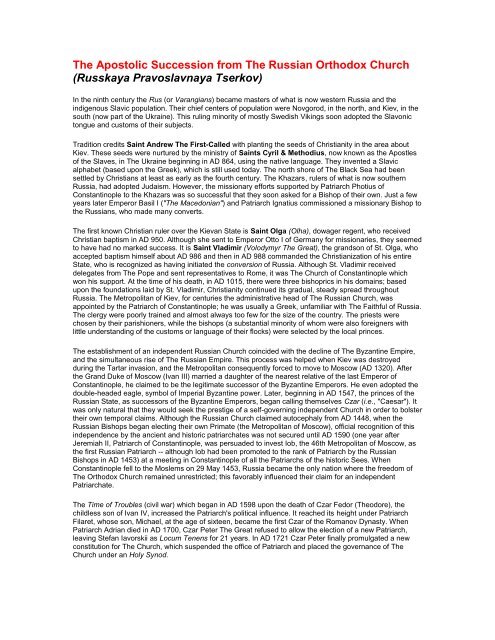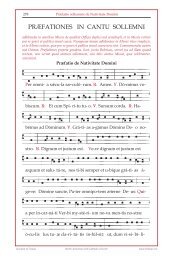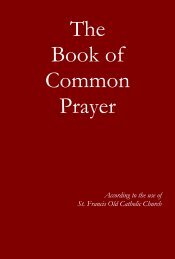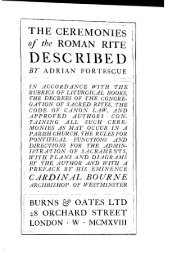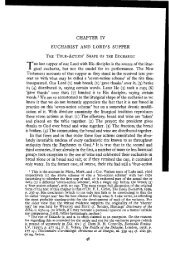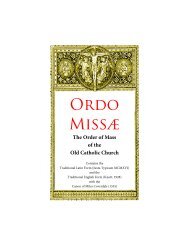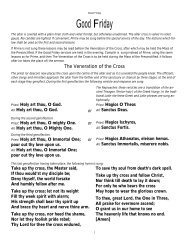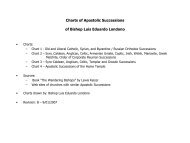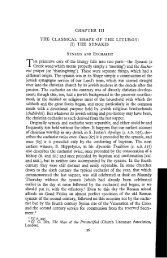Official Record of Apostolic Succession of
Official Record of Apostolic Succession of
Official Record of Apostolic Succession of
Create successful ePaper yourself
Turn your PDF publications into a flip-book with our unique Google optimized e-Paper software.
The <strong>Apostolic</strong> <strong>Succession</strong> from The Russian Orthodox Church<br />
(Russkaya Pravoslavnaya Tserkov)<br />
In the ninth century the Rus (or Varangians) became masters <strong>of</strong> what is now western Russia and the<br />
indigenous Slavic population. Their chief centers <strong>of</strong> population were Novgorod, in the north, and Kiev, in the<br />
south (now part <strong>of</strong> the Ukraine). This ruling minority <strong>of</strong> mostly Swedish Vikings soon adopted the Slavonic<br />
tongue and customs <strong>of</strong> their subjects.<br />
Tradition credits Saint Andrew The First-Called with planting the seeds <strong>of</strong> Christianity in the area about<br />
Kiev. These seeds were nurtured by the ministry <strong>of</strong> Saints Cyril & Methodius, now known as the Apostles<br />
<strong>of</strong> the Slaves, in The Ukraine beginning in AD 864, using the native language. They invented a Slavic<br />
alphabet (based upon the Greek), which is still used today. The north shore <strong>of</strong> The Black Sea had been<br />
settled by Christians at least as early as the fourth century. The Khazars, rulers <strong>of</strong> what is now southern<br />
Russia, had adopted Judaism. However, the missionary efforts supported by Patriarch Photius <strong>of</strong><br />
Constantinople to the Khazars was so successful that they soon asked for a Bishop <strong>of</strong> their own. Just a few<br />
years later Emperor Basil I ("The Macedonian") and Patriarch Ignatius commissioned a missionary Bishop to<br />
the Russians, who made many converts.<br />
The first known Christian ruler over the Kievan State is Saint Olga (Olha), dowager regent, who received<br />
Christian baptism in AD 950. Although she sent to Emperor Otto I <strong>of</strong> Germany for missionaries, they seemed<br />
to have had no marked success. It is Saint Vladimir (Volodymyr The Great), the grandson <strong>of</strong> St. Olga, who<br />
accepted baptism himself about AD 986 and then in AD 988 commanded the Christianization <strong>of</strong> his entire<br />
State, who is recognized as having initiated the conversion <strong>of</strong> Russia. Although St. Vladimir received<br />
delegates from The Pope and sent representatives to Rome, it was The Church <strong>of</strong> Constantinople which<br />
won his support. At the time <strong>of</strong> his death, in AD 1015, there were three bishoprics in his domains; based<br />
upon the foundations laid by St. Vladimir, Christianity continued its gradual, steady spread throughout<br />
Russia. The Metropolitan <strong>of</strong> Kiev, for centuries the administrative head <strong>of</strong> The Russian Church, was<br />
appointed by the Patriarch <strong>of</strong> Constantinople; he was usually a Greek, unfamiliar with The Faithful <strong>of</strong> Russia.<br />
The clergy were poorly trained and almost always too few for the size <strong>of</strong> the country. The priests were<br />
chosen by their parishioners, while the bishops (a substantial minority <strong>of</strong> whom were also foreigners with<br />
little understanding <strong>of</strong> the customs or language <strong>of</strong> their flocks) were selected by the local princes.<br />
The establishment <strong>of</strong> an independent Russian Church coincided with the decline <strong>of</strong> The Byzantine Empire,<br />
and the simultaneous rise <strong>of</strong> The Russian Empire. This process was helped when Kiev was destroyed<br />
during the Tartar invasion, and the Metropolitan consequently forced to move to Moscow (AD 1320). After<br />
the Grand Duke <strong>of</strong> Moscow (Ivan III) married a daughter <strong>of</strong> the nearest relative <strong>of</strong> the last Emperor <strong>of</strong><br />
Constantinople, he claimed to be the legitimate successor <strong>of</strong> the Byzantine Emperors. He even adopted the<br />
double-headed eagle, symbol <strong>of</strong> Imperial Byzantine power. Later, beginning in AD 1547, the princes <strong>of</strong> the<br />
Russian State, as successors <strong>of</strong> the Byzantine Emperors, began calling themselves Czar (i.e., "Caesar"). It<br />
was only natural that they would seek the prestige <strong>of</strong> a self-governing independent Church in order to bolster<br />
their own temporal claims. Although the Russian Church claimed autocephaly from AD 1448, when the<br />
Russian Bishops began electing their own Primate (the Metropolitan <strong>of</strong> Moscow), <strong>of</strong>ficial recognition <strong>of</strong> this<br />
independence by the ancient and historic patriarchates was not secured until AD 1590 (one year after<br />
Jeremiah II, Patriarch <strong>of</strong> Constantinople, was persuaded to invest Iob, the 46th Metropolitan <strong>of</strong> Moscow, as<br />
the first Russian Patriarch -- although Iob had been promoted to the rank <strong>of</strong> Patriarch by the Russian<br />
Bishops in AD 1453) at a meeting in Constantinople <strong>of</strong> all the Patriarchs <strong>of</strong> the historic Sees. When<br />
Constantinople fell to the Moslems on 29 May 1453, Russia became the only nation where the freedom <strong>of</strong><br />
The Orthodox Church remained unrestricted; this favorably influenced their claim for an independent<br />
Patriarchate.<br />
The Time <strong>of</strong> Troubles (civil war) which began in AD 1598 upon the death <strong>of</strong> Czar Fedor (Theodore), the<br />
childless son <strong>of</strong> Ivan IV, increased the Patriarch's political influence. It reached its height under Patriarch<br />
Filaret, whose son, Michael, at the age <strong>of</strong> sixteen, became the first Czar <strong>of</strong> the Romanov Dynasty. When<br />
Patriarch Adrian died in AD 1700, Czar Peter The Great refused to allow the election <strong>of</strong> a new Patriarch,<br />
leaving Stefan Iavorskii as Locum Tenens for 21 years. In AD 1721 Czar Peter finally promulgated a new<br />
constitution for The Church, which suspended the <strong>of</strong>fice <strong>of</strong> Patriarch and placed the governance <strong>of</strong> The<br />
Church under an Holy Synod.


